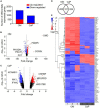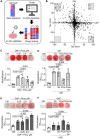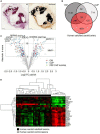Distinct role of mitochondrial function and protein kinase C in intimal and medial calcification in vitro
- PMID: 36204585
- PMCID: PMC9530266
- DOI: 10.3389/fcvm.2022.959457
Distinct role of mitochondrial function and protein kinase C in intimal and medial calcification in vitro
Abstract
Introduction: Vascular calcification (VC) is a major risk factor for cardiovascular morbidity and mortality. Depending on the location of mineral deposition within the arterial wall, VC is classified as intimal and medial calcification. Using in vitro mineralization assays, we developed protocols triggering both types of calcification in vascular smooth muscle cells (SMCs) following diverging molecular pathways.
Materials and methods and results: Human coronary artery SMCs were cultured in osteogenic medium (OM) or high calcium phosphate medium (CaP) to induce a mineralized extracellular matrix. OM induces osteoblast-like differentiation of SMCs-a key process in intimal calcification during atherosclerotic plaque remodeling. CaP mimics hyperphosphatemia, associated with chronic kidney disease-a risk factor for medial calcification. Transcriptomic analysis revealed distinct gene expression profiles of OM and CaP-calcifying SMCs. OM and CaP-treated SMCs shared 107 differentially regulated genes related to SMC contraction and metabolism. Real-time extracellular efflux analysis demonstrated decreased mitochondrial respiration and glycolysis in CaP-treated SMCs compared to increased mitochondrial respiration without altered glycolysis in OM-treated SMCs. Subsequent kinome and in silico drug repurposing analysis (Connectivity Map) suggested a distinct role of protein kinase C (PKC). In vitro validation experiments demonstrated that the PKC activators prostratin and ingenol reduced calcification triggered by OM and promoted calcification triggered by CaP.
Conclusion: Our direct comparison results of two in vitro calcification models strengthen previous observations of distinct intracellular mechanisms that trigger OM and CaP-induced SMC calcification in vitro. We found a differential role of PKC in OM and CaP-calcified SMCs providing new potential cellular and molecular targets for pharmacological intervention in VC. Our data suggest that the field should limit the generalization of results found in in vitro studies using different calcification protocols.
Keywords: drug repurposing; matrix mineralization; mitochondrial function; protein kinase C; vascular calcification; vascular smooth muscle cells.
Copyright © 2022 Heuschkel, Babler, Heyn, van der Vorst, Steenman, Gesper, Kappel, Magne, Gouëffic, Kramann, Jahnen-Dechent, Marx, Quillard and Goettsch.
Conflict of interest statement
The authors declare that the research was conducted in the absence of any commercial or financial relationships that could be construed as a potential conflict of interest. The reviewer JE declared a shared affiliation with one of the author RK to the handling editor at the time of review.
Figures






Similar articles
-
GRP75 inhibition attenuates arterial calcification.Atherosclerosis. 2025 May 15:119243. doi: 10.1016/j.atherosclerosis.2025.119243. Online ahead of print. Atherosclerosis. 2025. PMID: 40410081
-
Proteoglycan 4 Modulates Osteogenic Smooth Muscle Cell Differentiation during Vascular Remodeling and Intimal Calcification.Cells. 2021 May 21;10(6):1276. doi: 10.3390/cells10061276. Cells. 2021. PMID: 34063989 Free PMC article.
-
Osteomodulin attenuates smooth muscle cell osteogenic transition in vascular calcification.Clin Transl Med. 2022 Feb;12(2):e682. doi: 10.1002/ctm2.682. Clin Transl Med. 2022. PMID: 35184400 Free PMC article.
-
Calcium deposition within coronary atherosclerotic lesion: Implications for plaque stability.Atherosclerosis. 2020 Aug;306:85-95. doi: 10.1016/j.atherosclerosis.2020.05.017. Epub 2020 Jun 14. Atherosclerosis. 2020. PMID: 32654790 Review.
-
Vascular Calcification Mechanisms: Updates and Renewed Insight into Signaling Pathways Involved in High Phosphate-Mediated Vascular Smooth Muscle Cell Calcification.Biomedicines. 2021 Jul 12;9(7):804. doi: 10.3390/biomedicines9070804. Biomedicines. 2021. PMID: 34356868 Free PMC article. Review.
Cited by
-
Supplement of exogenous inorganic pyrophosphate inhibits atheromatous calcification in Apolipoprotein E knockout mice.Heliyon. 2023 Aug 16;9(8):e19214. doi: 10.1016/j.heliyon.2023.e19214. eCollection 2023 Aug. Heliyon. 2023. PMID: 37654451 Free PMC article.
-
Hypotaurine Reduces Glucose-Mediated Vascular Calcification.Acta Physiol (Oxf). 2025 Aug;241(8):e70075. doi: 10.1111/apha.70075. Acta Physiol (Oxf). 2025. PMID: 40620033 Free PMC article.
-
The Role of Mitochondrial Dysfunction in CKD-Related Vascular Calcification: From Mechanisms to Therapeutics.Kidney Int Rep. 2024 May 14;9(9):2596-2607. doi: 10.1016/j.ekir.2024.05.005. eCollection 2024 Sep. Kidney Int Rep. 2024. PMID: 39291213 Free PMC article. Review.
References
-
- Lozano R, Naghavi M, Foreman K, Lim S, Shibuya K, Aboyans V, et al. Global and regional mortality from 235 causes of death for 20 age groups in 1990 and 2010: A systematic analysis for the global burden of disease study 2010. Lancet. (2012) 380:2095–128. 10.1016/s0140-6736(12)61728-0 - DOI - PMC - PubMed
LinkOut - more resources
Full Text Sources
Molecular Biology Databases
Miscellaneous

